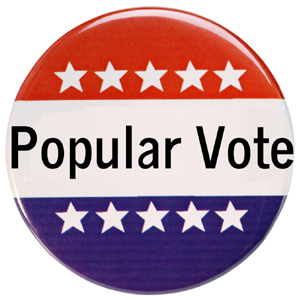For an alternate viewpoint, see “Point: The Electoral College Protects Minority Views and Discourages Fraud.”
How we elect our presidents has never been more broken — and that’s saying something for an Electoral College system subject to more proposed constitutional amendments than any other topic. We urgently need popular vote elections that treat every voter equally — and can do so by 2028.
When Congress recently certified the presidential election, it was based on the votes of 538 faceless electors, not the people. Those electors were selected according to laws that partisans in 48 states have ensured the awarding of 100 percent of electors to the candidate with the most votes in that state. Because of these laws, campaigns ignore states where the outcome is certain — which today means 44 of our 51 states (counting the Districts of Columbia).
In 2020 and 2024, 19 of every 20 presidential campaign events occurred in Arizona, Georgia, Michigan, Nevada, Pennsylvania or Wisconsin. The concerns of Americans in spectator states aren’t relevant to campaigns and are under-served between elections. Because only swing states matter, five presidents have assumed office after losing the popular vote.
The yawning gap between swing and spectator states destroys common Electoral College defenses. Less populous states are ignored, with Nevada the only battleground among the 31 smallest states. Most rural Americans haven’t cast a meaningful vote for president in their lifetimes.
Big-city voters should matter, too, but they won’t decide popular vote elections more than anyone else. That explains why Republicans since 2000 have won gubernatorial elections in 49 states and how Donald Trump comfortably won the popular vote in 2024.
Having seven predictable swing states incentivizes fraud and divisive litigation. Trump lost in 2020 by 7 million votes, but he could claim fraud because a shift of merely 21,461 swing state voters would have reversed the outcome. In 2024, Trump won by 2,284,338 votes, but he would have lost with a shift of 115,000 voters.
Minor parties affect presidential elections far more than in other elections, with the decisive swing state winning without a majority in five of our last nine elections. With operatives cynically weaponizing voter choice, expect increasing shenanigans involving minor parties if swing states don’t join Alaska and Maine in protecting majority rule with ranked-choice voting.
The Electoral College gets even worse when candidates fall short of 270 electoral votes, as can happen with an Electoral College tie or if independents win states. Imagine the chaos if Congress decided the presidency, with the House electing the president and the Senate able to pick a different party’s vice president.
The status of being a spectator state is nearly cemented. Consider that Republicans hold all 48 Senate seats in the spectator states won by Donald Trump but only one in the 19 states he lost. Democrats hold 198 of the 200 House seats with a partisan index favoring them by at least 4 percent, while Republicans have 213 of 216 seats comparably favoring them. With such predictable outcomes, don’t expect a new swing state in 2028.
Yet, we can take action. Barely a century ago, Americans amended the Constitution to establish Senate elections and enfranchise women. In 1969, the House overwhelmingly approved an amendment abolishing the Electoral College. It’s time for a robust debate about a popular vote amendment and whether it should strengthen voting rights, allow citizens in the territories to vote, and uphold majority rule with ranked-choice voting.
States don’t have to wait. Seventeen states and the District of Columbia have passed laws joining the National Popular Vote compact, which is grounded in constitutional provisions giving states exclusive control over how to award electoral votes and the power to bind their agreements. The popular vote compact establishes that once the law in states with a majority of electors, participating states will award their electoral votes to the winner of the national popular vote in all 50 states and D.C. We can have a popular vote election as soon as 2028 if just a few more states join the compact by initiative or if it wins legislatively in states where at least one chamber has passed it.
History shows that Americans can do anything when duty calls. Let’s live up to our proud tradition by reforming the Electoral College.





